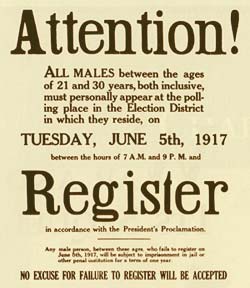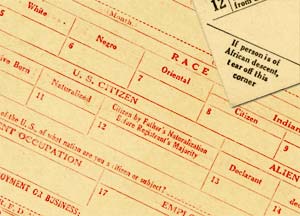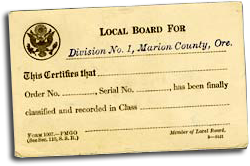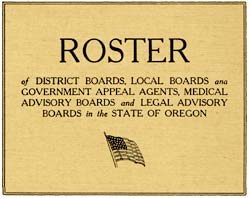 Men who failed to register for the draft risked spending a year in jail. Nine million American men registered in early June.
Men who failed to register for the draft risked spending a year in jail. Nine million American men registered in early June.
Settling on a Draft
With the declaration of war in April 1917, American leaders had to make decisions about how to mobilize millions of men for military service. Many people, such as former president Teddy Roosevelt, held a romantic attachment to voluntary military service. And certainly, America's experience with a system of conscription or compulsory military service during the Union draft of the Civil War was seen as an example of how not to raise an army. That draft resulted in gross unfairness through the hiring of substitutes and other dubious actions, spawning protests and riots.
In the end, President Wilson and his advisors settled on the draft as the only efficient and democratic way to raise a large army. In contrast to the Civil War draft, Wilson sought to spread the obligation for duty among all qualified men, regardless of their social or economic standing. The Selective Service Act required all males from 21 to 30 go to their election precinct polling place to register in early June 1917. Subsequently, men were expected to appear when they turned 21 years old. In 1918 draft ages were expanded to include those aged 18 to 45. By the end of the war, more than 24 million men registered for the draft with almost three million being inducted into the Army.
No Excuse for Failure to Register
 Draft registration cards. During a time of strict Jim Crow segregation laws in the southern U.S, the military separated racial minorities. (OSA, Oregon Defense Council Records, Publications and Ephemera, Box 9, Folder 1)
Draft registration cards. During a time of strict Jim Crow segregation laws in the southern U.S, the military separated racial minorities. (OSA, Oregon Defense Council Records, Publications and Ephemera, Box 9, Folder 1)
The Selective Service Department set up district boards in Portland, Eugene, and La Grande. Each of these had jurisdiction over a number of local draft boards. Because of Portland's size, it included 10 local board divisions. Marion County had two. Otherwise, the boards were located in each of Oregon's county seats.
Registering for the draft was a long and bureaucratic exercise. Numerous forms and cards waited for completion. A 16 page questionnaire walked through nearly every aspect of a registrant's life. Failure to fill it out within seven days could result in a "fine or imprisonment for one year and may result in the loss of valuable rights and immediate induction into military service."
The first, and probably most important, question confronting the registrant was that of making a claim for exemption or deferred classification from the draft. The law held that "the names of all men liable to selection for military service shall be arranged in five classes in the order in which they can best be spared from the civic, family, industrial, and agricultural institutions of the Nation." In simplified form, the system included:
 Local draft boards issued cards to men once they had been officially classified for deferment or exemption. (OSA, Oregon Defense Council Records, Publications and Ephemera, Box 9, Folder 1)
Local draft boards issued cards to men once they had been officially classified for deferment or exemption. (OSA, Oregon Defense Council Records, Publications and Ephemera, Box 9, Folder 1)
- Class I: Every man in this class was "presently liable for military service." These included most single men, unskilled laborers, and certain married men.
- Class II: These men were "temporarily deferred" from service until Class I was exhausted. They generally included certain married men with dependents and "necessary" skilled labor.
- Class III: These men were "temporarily deferred" from service until Class II was exhausted. They generally included certain men with dependent infirm or "helpless" relatives as well as certain types of government workers and other "necessary" workers.
-
Class IV: These men were "temporarily deferred" from service until Class III was exhausted. They generally included men with families that were "mainly dependent on his labor for support" as well as merchant mariners and managers of "necessary enterprises."
-
Class V: These men were "exempted or discharged" from service. They generally included legislative, executive, or judicial officers of government, ministers, aliens, the "totally and permanently physically or mentally unfit" as well as the "morally unfit."
A separate line allowed for a claim of exemption based on religious convictions against participating in war - the conscientious objector.
The rest of the questionnaire asked detailed questions, 32 on dependents alone, related to supporting claims made for exemption or deferred classification and required affidavits in support. Legal advisory boards, consisting of "disinterested lawyers and laymen" were available at draft board offices throughout Oregon to advise registrants on the "true meaning and intent" of the law.
View draft registration questionnaire (PDF).
Your Local Draft Board
Once the forms and questionnaires were completed, the local draft board would begin processing the registration and a folder would fill with the resulting paperwork, noting each step of the process. If the registration progressed to the point at which the registrant were ordered to report for a physical examination, the report of the examining physician would be included, as would the report of the medical advisory board. Twenty-five of these boards scattered throughout Oregon examined records and determined the physical qualifications of the registrants. They had four choices: qualified; qualified but deferred; qualified for limited service; and disqualified. The medical board's decision was forwarded to the local draft board, which ruled on the same criteria. If the individual appealed the action, the district draft board would rule.
 Various boards related to administering the draft sprang up throughout Oregon in the spring of 1917. The Adjutant General's Office published this roster. (OSA, Oregon Defense Council Records, Publications and Ephemera, Box 9, Folder 1)
Various boards related to administering the draft sprang up throughout Oregon in the spring of 1917. The Adjutant General's Office published this roster. (OSA, Oregon Defense Council Records, Publications and Ephemera, Box 9, Folder 1)
Registrants who passed the physical examination would be ordered to report for service. If they failed to report, they first would be listed as delinquent and later as deserters who were to be "apprehended." Those who reported as ordered eventually would find themselves at mobilization camp where they would be either accepted, rejected, or discharged.
Of course, for those not immediately inducted into the military, there were continuing responsibilities related to the draft. If any change occurred that could affect their deferred or exempt status, they were to report it to the local draft board within five days. They were also required to examine "from time to time" notices posted by the local draft board in case changes to the system affected their status.
Results May Vary
The public voiced little opposition to the draft over the course of the war. Some of this could be attributed to fear of criticizing a government that was beginning to crack down on "disloyal" rhetoric. But most Americans saw the need for the draft and believed that, while not perfect, the classification system generally was fair. Certainly, as with any system of its size and complexity, favoritism, bribery, intimidation, and other forms of corruption occurred at local draft boards. But the system held up even as it lowered the draft age from 21 to 18, thereby edging closer to the sight of "taking boys from their mothers' arms."
Opinions differed on the quality of the soldier produced by the draft. Overall, consensus holds the drafted soldiers fought just as heroically as the two million men who enlisted in the various armed services. But at least one Oregon man, Martin Luther Kimmel, who had enlisted in the Army held a different attitude:
Notes
(Oregon State Defense Council Records, Publications and Ephemera, Box 9, Folder 1; State Historian's Correspondence, Box 1, Folder 15; Oregon Historical Quarterly, vol. 75, page 265)